Study on the Coupling Coordination Degree and Driving Mechanism of “Production-Living-Ecological” Space in Ecologically Fragile Areas: A Case Study of the Turpan–Hami Basin
Abstract
1. Introduction
2. Materials and Methods
2.1. Study Area
2.2. Data
2.3. Method
2.3.1. Categorization of Land Use Within PLES
2.3.2. Land-Use Transfer Matrix
2.3.3. Construction of a PLE Functional Evaluation Indicator System for Ecologically Vulnerable Areas
- 1.
- Data Standardization
- 2.
- Entropy weighting method to determine weights
- 3.
- Constructing a comprehensive evaluation model
2.3.4. Coupled Coordination Degree Model
2.3.5. Geodetector
- 1.
- Factor detection
- 2.
- Interaction detection
3. Results
3.1. Analysis of the PLE Function Evaluation Index System in the Turpan–Hami Basin
3.2. Evolutionary Characteristics of the Spatial and Temporal Dynamics of PLES in the Turpan–Hami Basin
3.3. Evaluation and Analysis of PLE Functions in Turpan–Hami Basin
3.3.1. Analysis of the Functional Spatial Evolution of PLE at the Grid Scale
3.3.2. Analysis at the County Scale of the Spatial Evolution Pattern of PLE Functions
3.4. Spatiotemporal Analysis of PLES Coupling Harmonization in the Turpan–Hami Basin
3.5. Analysis of the Drivers of PLES Coupling Coherence in the Turpan–Hami Basin
4. Discussion
4.1. Development of PLES in the Turpan–Hami Basin and Spatiotemporal Variations in Coupling Coherence
4.2. Analysis of Drivers of PLES Coupling Coherence in the Turpan–Hami Basin
4.3. Contributions and Limitations
5. Conclusions
- (1)
- Over the past decade, the Turpan–Hami Basin has seen its production spaces gradually transition to living and ecological spaces, reflecting the progress of urbanization, improvement in living conditions, and effective implementation of ecological protection measures. Overall, the CCD of the PLES in the basin is high and trending upwards, particularly in regions with better transportation and faster urbanization, such as the Gaochang and Yizhou districts.
- (2)
- Evapotranspiration and total population are key driving factors affecting the CCD of the PLES in the region, with their interaction significantly impacting coordinated regional development. This study highlights the critical role of areas with dense water resources and concentrated populations in fostering coordinated development, suggesting that future regional planning should focus on balancing economic growth with resource utilization.
Author Contributions
Funding
Institutional Review Board Statement
Informed Consent Statement
Data Availability Statement
Conflicts of Interest
References
- Grimm, N.B.; Faeth, S.H.; Golubiewski, N.E.; Redman, C.L.; Wu, J.; Bai, X.; Briggs, J.M. Global change and the ecology of cities. Science 2008, 319, 756–760. [Google Scholar] [CrossRef]
- Lilin, Z.; Yansui, L.; Yongsheng, W. Research progress and prospect of land-use conflicts in China. Prog. Geogr. 2020, 39, 298–309. [Google Scholar] [CrossRef]
- Shidong, L.; Moucheng, L.; Yingfa, C. Beautiful Ecology: Theoretical Exploration Index Evaluation and Development Strategy; Science Press: Beijing, China, 2017. [Google Scholar]
- Li, J.; Sun, W.; Li, M.; Meng, L. Coupling coordination degree of production, living and ecological spaces and its influencing factors in the Yellow River Basin. J. Clean. Prod. 2021, 298, 126803. [Google Scholar] [CrossRef]
- Zhang, R.; Li, S.; Wei, B.; Zhou, X. Characterizing Production-Living-Ecological Space Evolution and Its Driving Factors: A Case Study of the Chaohu Lake Basin in China from 2000 to 2020. ISPRS Int. J. Geo-Inf. 2022, 11, 447. [Google Scholar] [CrossRef]
- Lin, G.; Jiang, D.; Fu, J.; Zhao, Y. A Review on the Overall Optimization of Production–Living–Ecological Space: Theoretical Basis and Conceptual Framework. Land 2022, 11, 345. [Google Scholar] [CrossRef]
- Cui, X.; Fang, C.; Liu, H.; Liu, X. Assessing sustainability of urbanization by a coordinated development index for an Urbanization-Resources-Environment complex system: A case study of Jing-Jin-Ji region, China. Ecol. Indic. 2019, 96, 383–391. [Google Scholar] [CrossRef]
- Yue, B. An analysis on the EU’s multifunctional agriculture. J. Huazhong Agric. Univ. (Soc. Sci.) 2006, 2, 31–34. [Google Scholar] [CrossRef]
- Wei, L.; Zhang, Y.; Wang, L.; Mi, X.; Wu, X.; Cheng, Z. Spatiotemporal Evolution Patterns of “Production-Living-Ecological” Spaces and the Coordination Level and Optimization of the Functions in Jilin Province. Sustainability 2021, 13, 13192. [Google Scholar] [CrossRef]
- Sun, Y.; Huang, R.; Chen, P.; Zhang, L. Classification and function evaluation of “production-life-ecology space”—Taking Jilin Province as an example. Jiangsu J. Agric. Sci. 2020, 48, 298–304+309. [Google Scholar] [CrossRef]
- Yu-Mei, C.; Lin-Sheng, G.U.; Jing-Yu, L.I.; Shu-Kun, P. Evolvement and Inspiration of National Land Comprehensive Development Planning in Japan. China Land Sci. 2008, 22, 76–80. [Google Scholar] [CrossRef]
- Kariminejad, N.; Hosseinalizadeh, M.; Pourghasemi, H.R.; Bernatek-Jakiel, A.; Campetella, G.; Ownegh, M. Evaluation of factors affecting gully headcut location using summary statistics and the maximum entropy model: Golestan Province, NE Iran. Sci. Total Environ. 2019, 677, 281–298. [Google Scholar] [CrossRef] [PubMed]
- Houkai, W.; Chunliang, G. China’s Trends in Regional Coordinated Development and Ideas on Policy Adjustment %J Henan Social Sciences. Henan Soc. Sci. 2012, 20, 73–81. [Google Scholar] [CrossRef]
- Jie, F.; Kan, Z.; Wei, S.; Dong, C. Scientific values and research innovations of Human-economic Geography in construction of ecological civilization. Prog. Geogr. 2013, 32, 147–160. [Google Scholar] [CrossRef]
- Groot, R.D. Function-analysis and valuation as a tool to assess land use conflicts in planning for sustainable, multi-functional landscapes. Landsc. Urban Plan. 2006, 75, 175–186. [Google Scholar] [CrossRef]
- Willemen, L.; Hein, L.; van Mensvoort, M.E.; Verburg, P.H. Space for people, plants, and livestock? Quantifying interactions among multiple landscape functions in a Dutch rural region. Ecol. Indic. 2010, 10, 62–73. [Google Scholar] [CrossRef]
- Ricketts, T.H.; Daily, G.C.; Ehrlich, P.R.; Michener, C.D. Economic value of tropical forest to coffee production. Proc. Natl. Acad. Sci. USA 2004, 101, 12579–12582. [Google Scholar] [CrossRef] [PubMed]
- Paracchini, M.L.; Pacini, C.; Jones, M.L.M.; Pérez-Soba, M. An aggregation framework to link indicators associated with multifunctional land use to the stakeholder evaluation of policy options. Ecol. Indic. 2011, 11, 71–80. [Google Scholar] [CrossRef]
- Liu, J.; Liu, Y.; Li, Y. Classification evaluation and spatial-temporal analysis of “production-living-ecological” spaces in China. Acta Geogr. Sin. 2017, 72, 1290–1304. [Google Scholar] [CrossRef]
- Li, G.; Fang, C. Quantitative function identification and analysis of urban ecological-production-living spaces. Acta Geogr. Sin. 2016, 71, 49–65. [Google Scholar] [CrossRef]
- Huang, J.; Lin, H.; Qi, X. A literature review on optimization of spatial development pattern based on ecological-production-living space. Prog. Hum. Geogr. 2017, 36, 378–391. [Google Scholar] [CrossRef]
- Gao, X.; Liu, Z.; Li, C. Land use Function Transformation and ecological environment effect in Xiongan New Area based on production-living-ecological space. Acta Ecol. Sin. 2020, 40, 1–10. [Google Scholar]
- Jia, Y.; Liu, J.; Fu, L.; Chen, Y.; Liu, K. Spatial Coupling and Coordination Relationship and Evaluation Analysis of “Production-living-ecology” Space in Rural Revitalization in Shandong Province. J. Nat. Sci. Hunan Norm. Univ. 2022, 50, 3. [Google Scholar] [CrossRef]
- Yushu, G.; Shuailong, G.; Changle, M.; Jianxin, Y.; Guanghuan, W.; Lixing, Y. Analysis on Spatial-temporal Pattern of Land Use Change and Coupling Coordination Degree in Huize County from the Perspective of “Production-Living-Ecological Space”. West. For. Sci. 2024, 53, 142–151. [Google Scholar] [CrossRef]
- Ding, L.; Zhao, W.; Huang, Y.; Cheng, S.; Liu, C. Research on the Coupling Coordination Relationship between Urbanization and the Air Environment: A Case Study of the Area of Wuhan. Atmosphere 2015, 6, 1539–1558. [Google Scholar] [CrossRef]
- Liu, N.; Liu, C.; Xia, Y.; Da, B. Examining the coordination between urbanization and eco-environment using coupling and spatial analyses: A case study in China. Ecol. Indic. 2018, 93, 1163–1175. [Google Scholar] [CrossRef]
- Liu, W.; Jiao, F.; Ren, L.; Xu, X.; Wang, J.; Wang, X. Coupling coordination relationship between urbanization and atmospheric environment security in Jinan City. J. Clean. Prod. 2018, 204, 1–11. [Google Scholar] [CrossRef]
- Shen, L.; Huang, Y.; Huang, Z.; Lou, Y.; Ye, G.; Wong, S.-W. Improved coupling analysis on the coordination between socio-economy and carbon emission. Ecol. Indic. 2018, 94, 357–366. [Google Scholar] [CrossRef]
- Guo, A.; Zhao, Z.; Yuan, Y.; Wang, Y.; Li, X.; Xu, R. Quantitative correlations between soil and plants in reclaimed mining dumps using a coupling coordination degree model. R. Soc. Open Sci. 2018, 5, 180484. [Google Scholar] [CrossRef] [PubMed]
- Han, H.; Li, H. Coupling coordination evaluation between population and land urbanization in Ha-Chang urban agglomeration. Sustainability 2020, 12, 357. [Google Scholar] [CrossRef]
- Jiaqi, C.; Yilin, L.; Junsan, Z.; Bingui, Q. Spatiotemporal Characteristics and Influencing Factors of Functional Coupling and Coordination of ‘Production-Living-Ecological’ Spaces in Kunming City. Res. Soil Water Conserv. 2024, 31, 299–310+319. [Google Scholar] [CrossRef]
- Xu, S.; He, W.; Shen, J.; Degefu, D.M.; Yuan, L.; Kong, Y. Coupling and coordination degrees of the core water-energy-food nexus in China. Int. J. Environ. Res. Public Health 2019, 16, 1648. [Google Scholar] [CrossRef] [PubMed]
- Wang, L.; Wang, J.; Ding, J.; Li, X. Estimation and Spatiotemporal Evolution Analysis of Actual Evapotranspiration in Turpan and Hami Cities Based on Multi-Source Data. Remote Sens. 2023, 15, 2565. [Google Scholar] [CrossRef]
- Cui, X.; Xu, N.; Chen, W.; Wang, G.; Liang, J.; Pan, S.; Duan, B. Spatio-temporal variation and influencing factors of the coupling coordination degree of production-living-ecological space in China. Int. J. Environ. Res. Public Health 2022, 19, 10370. [Google Scholar] [CrossRef] [PubMed]
- Bao, S.; Lu, L.; Zhi, J.; Li, J. An Optimization Strategy for Provincial “Production–Living–Ecological” Spaces under the Guidance of Major Function-Oriented Zoning in China. Sustainability 2024, 16, 2248. [Google Scholar] [CrossRef]
- Yi, Z.; Jianglong, T.; Jianji, Z. Research on the Spatial Coupling Harmonious Degree Spatial-Spatial Evolution of “Production-Living-Ecological Space” in Ganzhou Based on PLUS-MarKov Prediction Model. Jiangxi Sci. 2024, 42, 303–310+416. [Google Scholar] [CrossRef]
- Liang, T.; Yang, F.; Luo, Y.; Fang, M.; Huang, X.; Zhang, Z.; Wen, C.; Ren, X. The Synchronous Development Pattern and Type Division of Functional Coupling Coordination and Human Activity Intensity Based on the “Production–Living–Ecological” Space Perspective: A Case Study of Wanzhou District. Land 2022, 11, 1897. [Google Scholar] [CrossRef]
- Li, Y.; Zhang, S.; Zhao, J.; Zhang, G.; Qu, G.; Ma, S.; Liu, X. Spatiotemporal evolution and Sustainably comprehensive zoning optimization of production–living–ecological functions in the Mountain–Flatland areas. Heliyon 2024, 10, e23425. [Google Scholar] [CrossRef]
- Zhou, H.; Wu, X.; Nie, H.; Wang, X.; Zang, S. Coupling coordination analysis and obstacle factors identification of rural living-production-ecological functions in a farming-pastoral ecotone. Ecol. Indic. 2024, 158, 111398. [Google Scholar] [CrossRef]
- Zou, L.; Wang, J.; Hu, X. An classification systems of production-living-ecological land on the county level: Theory building and empirical research. China Land Sci. 2018, 32, 59–66. [Google Scholar] [CrossRef]
- Geng-ying, J.; Xiao-zhong, Y.; Zhi-qiang, H.; Xiao, Z.; Lin, L. Evolution characteristics and possible impact factors for the changing pattern and function of “Production-Living-Ecological” space in Wuyuan county. J. Nat. Resour. 2021, 36, 1252–1267. [Google Scholar] [CrossRef]
- Liao, G.; He, P.; Gao, X.; Lin, Z.; Huang, C.; Zhou, W.; Deng, O.; Xu, C.; Deng, L. Land use optimization of rural production–living–ecological space at different scales based on the BP–ANN and CLUE–S models. Ecol. Indic. 2022, 137, 108710. [Google Scholar] [CrossRef]
- Yu, Z.; Xu, E.; Zhang, H.; Shang, E. Spatio-temporal coordination and conflict of production-living-ecology land functions in the beijing-tianjin-hebei region, china. Land 2020, 9, 170. [Google Scholar] [CrossRef]
- Hongq, Z.; Erqi, X.; Huiyi, Z. An ecological-living-industrial land classification system and its spatial distribution in China. China. Resour. Sci. 2015, 37, 1332–1338. [Google Scholar] [CrossRef]
- Zhu, H.; Li, X. Discussion on the index method of regional land use change. Acta Geogr. Sin. 2003, 58, 643–650. [Google Scholar] [CrossRef]
- Dong, Q.; Zhong, K.; Liao, Y.; Xiong, R.; Wang, F.; Pang, M. Coupling coordination degree of environment, energy, and economic growth in resource-based provinces of China. Resour. Policy 2023, 81, 103308. [Google Scholar] [CrossRef]
- Li, Y.; Li, Y.; Zhou, Y.; Shi, Y.; Zhu, X. Investigation of a coupling model of coordination between urbanization and the environment. J. Environ. Manag. 2012, 98, 127–133. [Google Scholar] [CrossRef]
- Yang, Y.; Bao, W.; Liu, Y. Coupling coordination analysis of rural production-living-ecological space in the Beijing-Tianjin-Hebei region. Ecol. Indic. 2020, 117, 106512. [Google Scholar] [CrossRef]
- Yang, M.; Jiao, M.; Zhang, J. Coupling coordination and interactive response analysis of ecological environment and urban resilience in the Yangtze River Economic Belt. J. Environ. Res. Public Health 2022, 19, 11988. [Google Scholar] [CrossRef]
- Wang, J.; Xu, C. Geodetector: Principle and prospective. Acta Geogr. Sin. 2017, 72, 116–134. [Google Scholar] [CrossRef]
- Wu, Q.; Meng, J. Analysis of the Evolution and Driving Factors of Production-Living-Ecological Space Pattern in the Heihe River Basin from 1980 to 2020, China. J. Peking Univ. 2023, 59, 970–980. [Google Scholar] [CrossRef]
- Lyu, Y.; Shi, P.; Han, G.; Liu, L.; Guo, L.; Hu, X.; Zhang, G. Desertification Control Practices in China. Sustainability 2020, 12, 3258. [Google Scholar] [CrossRef]
- Xia, N.; Hai, W.; Tang, M.; Song, J.; Quan, W.; Zhang, B.; Ma, Y. Spatiotemporal evolution law and driving mechanism of production–living–ecological space from 2000 to 2020 in Xinjiang, China. Ecol. Indic. 2023, 154, 110807. [Google Scholar] [CrossRef]
- Gong, Z.; Yuan, Y.; Qie, L.; Huang, S.; Xie, X.; Zhong, R.; Pu, L. Spatiotemporal Differentiation and Coupling Coordination Relationship of the Production-Living-Ecological Function at County Scale: A Case Study of Jiangsu Province. Land 2023, 12, 2027. [Google Scholar] [CrossRef]
- Zhao, J.; Zhao, Y. Synergy/trade-offs and differential optimization of production, living, and ecological functions in the Yangtze River economic Belt, China. Ecol. Indic. 2023, 147, 109925. [Google Scholar] [CrossRef]
- Meng, J.; Cheng, H.; Li, F.; Han, Z.; Wei, C.; Wu, Y.; You, N.W.; Zhu, L. Spatial-temporal trade-offs of land multi-functionality and function zoning at finer township scale in the middle reaches of the Heihe River. Land Use Policy 2022, 115, 106019. [Google Scholar] [CrossRef]
- Huang, M.; Li, Y.; Li, M.; Chen, S.; Zeng, C.; Zhang, B.; Xia, C. Coupling response of human activity intensity and landscape pattern in the Three Gorges Reservoir Area. Acta Ecol. Sin. 2022, 42, 3959–3973. [Google Scholar] [CrossRef]
- Kou, Y.; Chen, S.; Zhou, K.; Qiu, Z.; He, J.; Shi, X.; Zhou, X.; Zhang, Q. Spatiotemporal Patterns and Coupling Coordination Analysis of Multiscale Social–Economic–Ecological Effects in Ecologically Vulnerable Areas Based on Multi-Source Data: A Case Study of the Tuha Region, Xinjiang Province. Land 2024, 13, 282. [Google Scholar] [CrossRef]
- Fan, Y.; Jin, X.; Gan, L.; Jessup, L.H.; Pijanowski, B.C.; Lin, J.; Yang, Q.; Lyu, L. Dynamics of spatial associations among multiple land use functions and their driving mechanisms: A case study of the Yangtze River Delta region, China. Environ. Impact Assess. Rev. 2022, 97, 106858. [Google Scholar] [CrossRef]
- Zhou, D.; Wang, X.; Shi, M. Human driving forces of oasis expansion in northwestern China during the last decade—A case study of the Heihe River basin. Land Degrad. Dev. 2017, 28, 412–420. [Google Scholar] [CrossRef]
- Yang, L.; Guan, Q.; Lin, J.; Tian, J.; Tan, Z.; Li, H. Evolution of NDVI secular trends and responses to climate change: A perspective from nonlinearity and nonstationarity characteristics. Remote Sens. Environ. 2021, 254, 112247. [Google Scholar] [CrossRef]
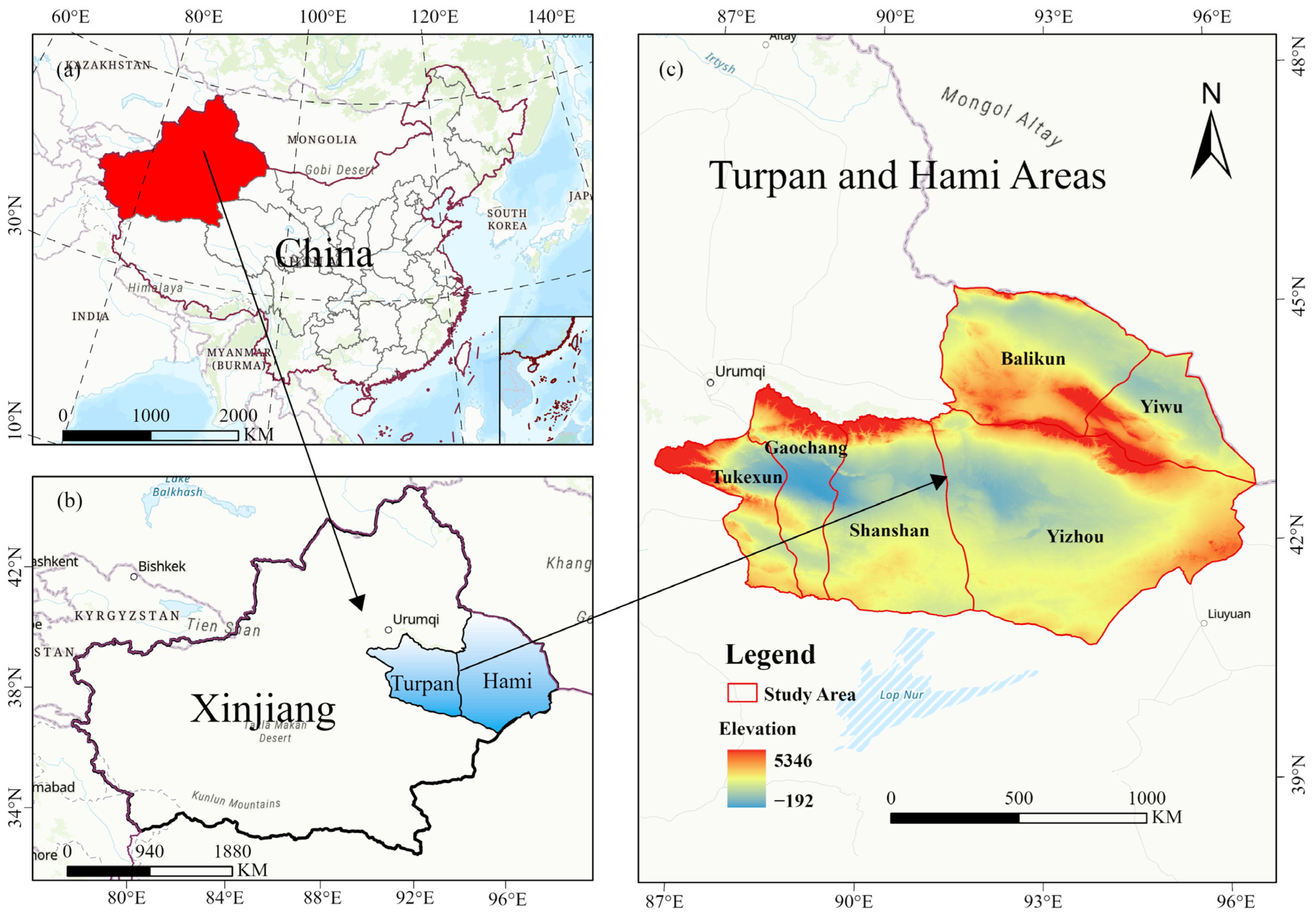

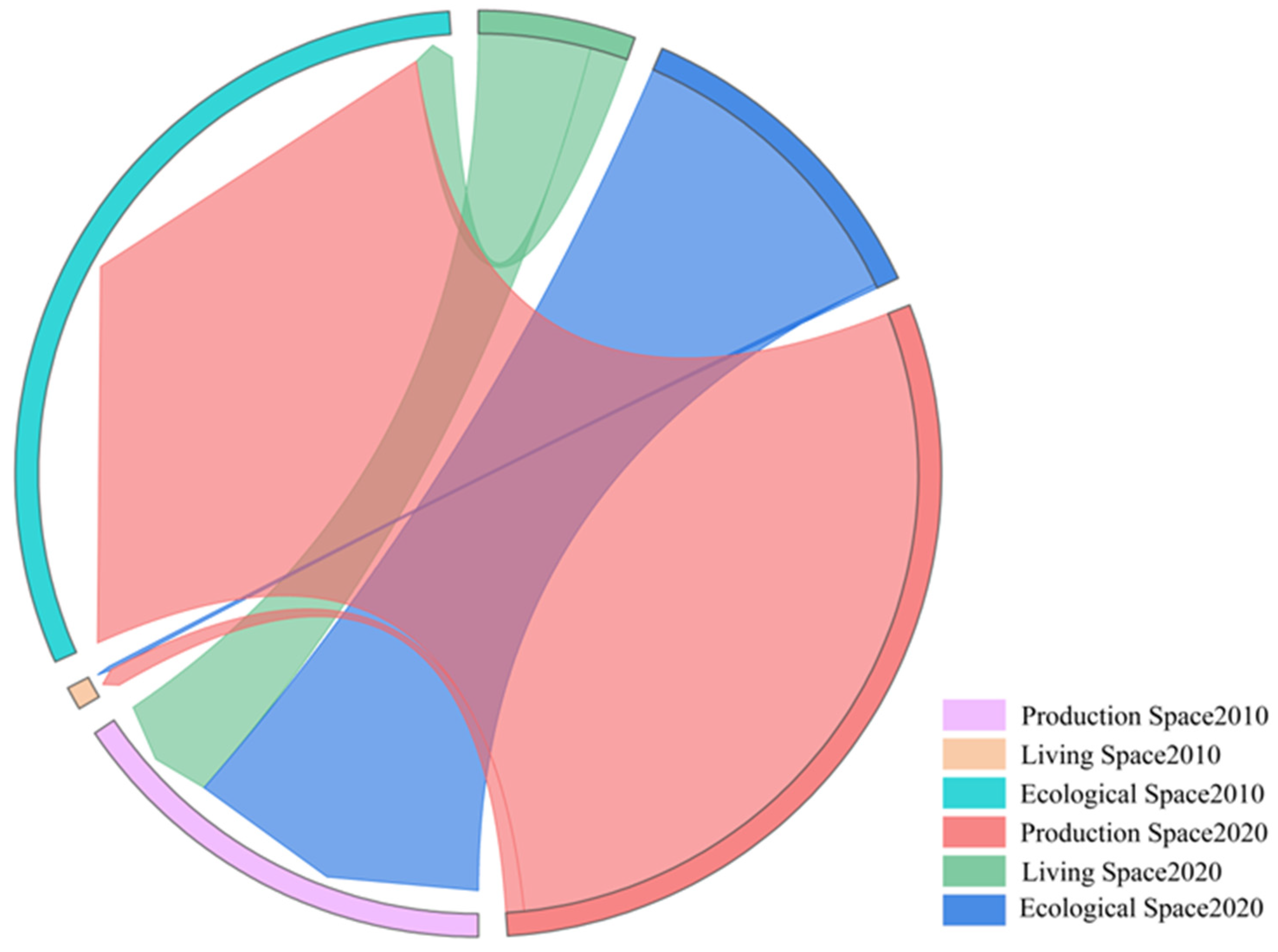
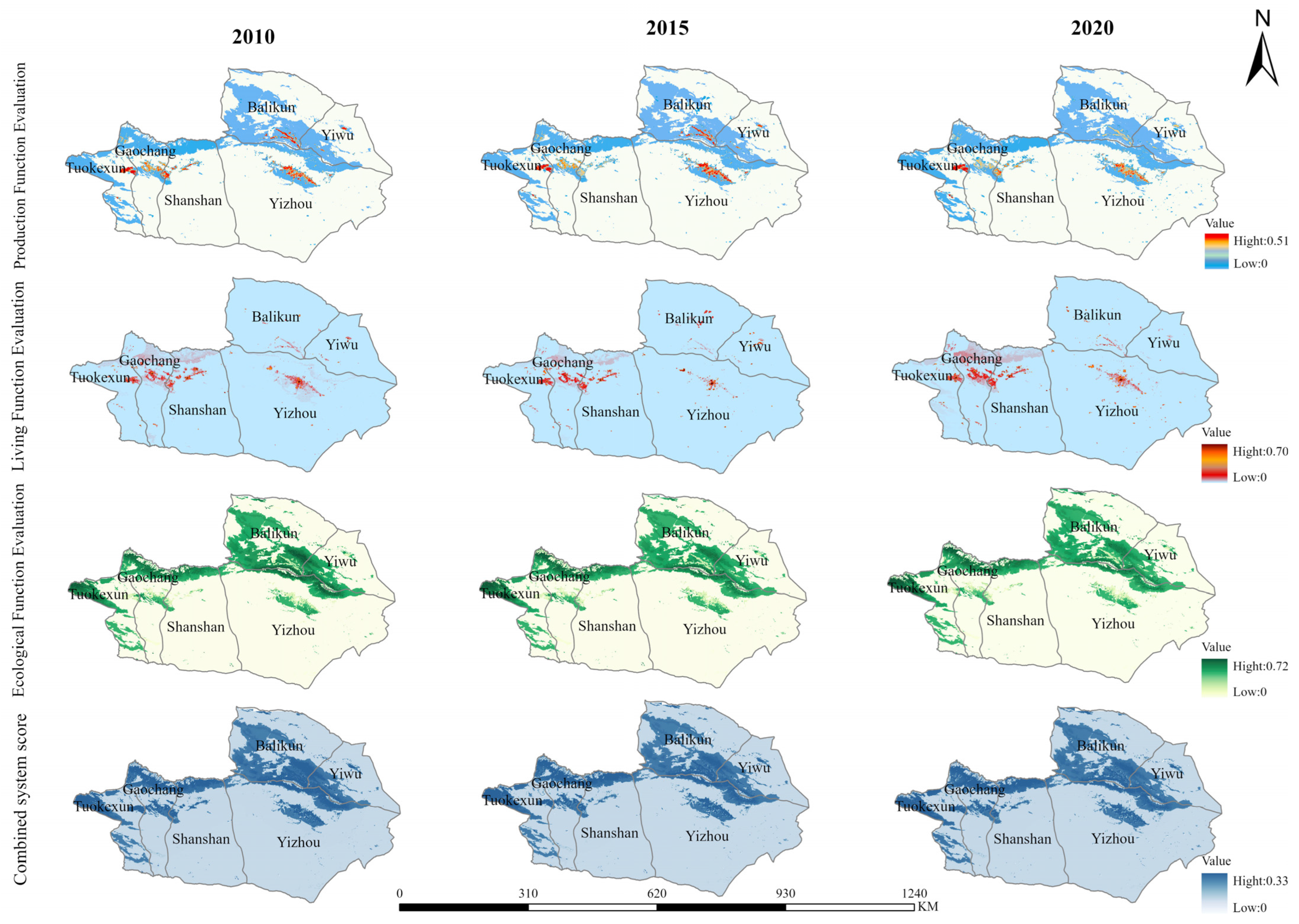
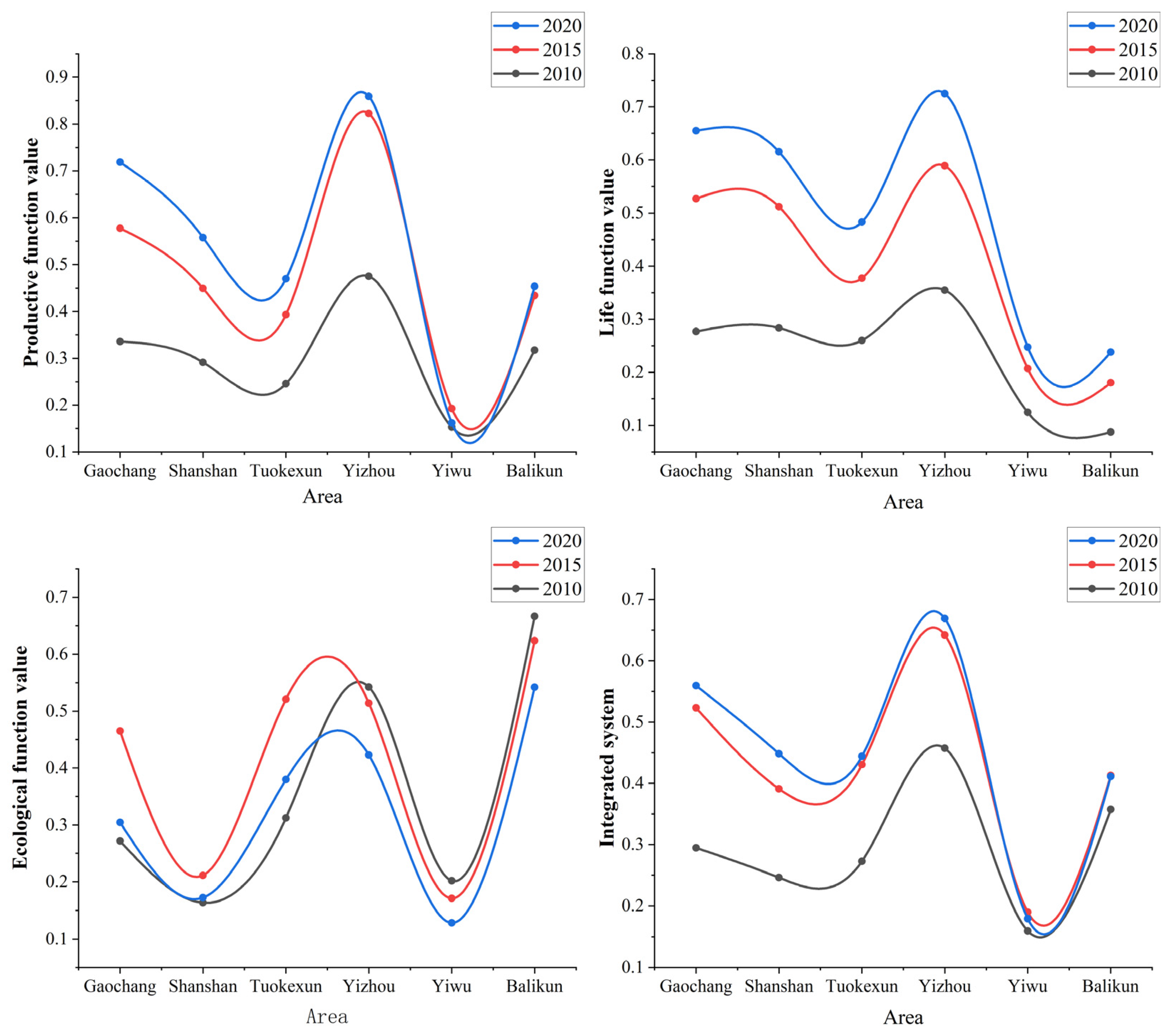
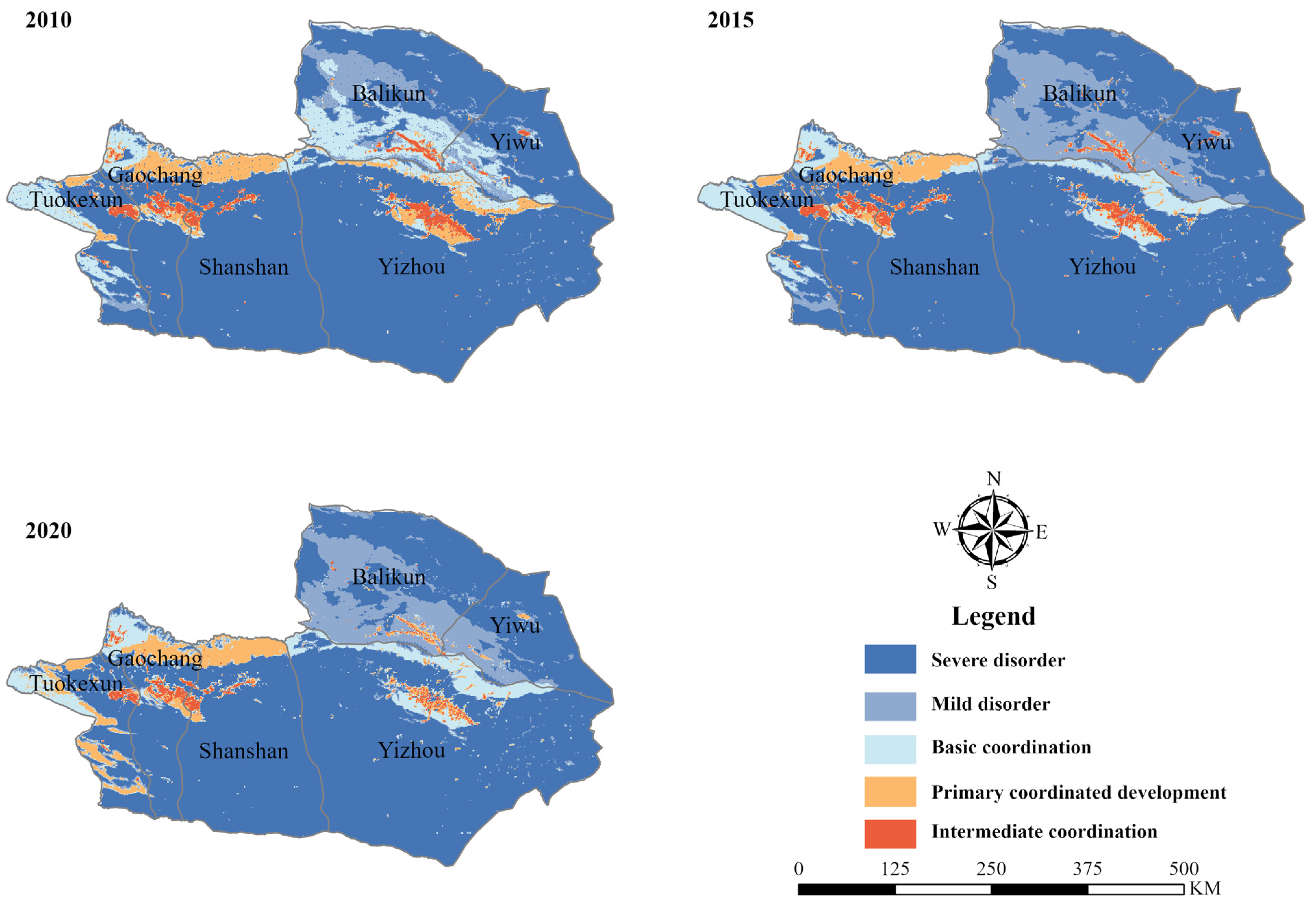
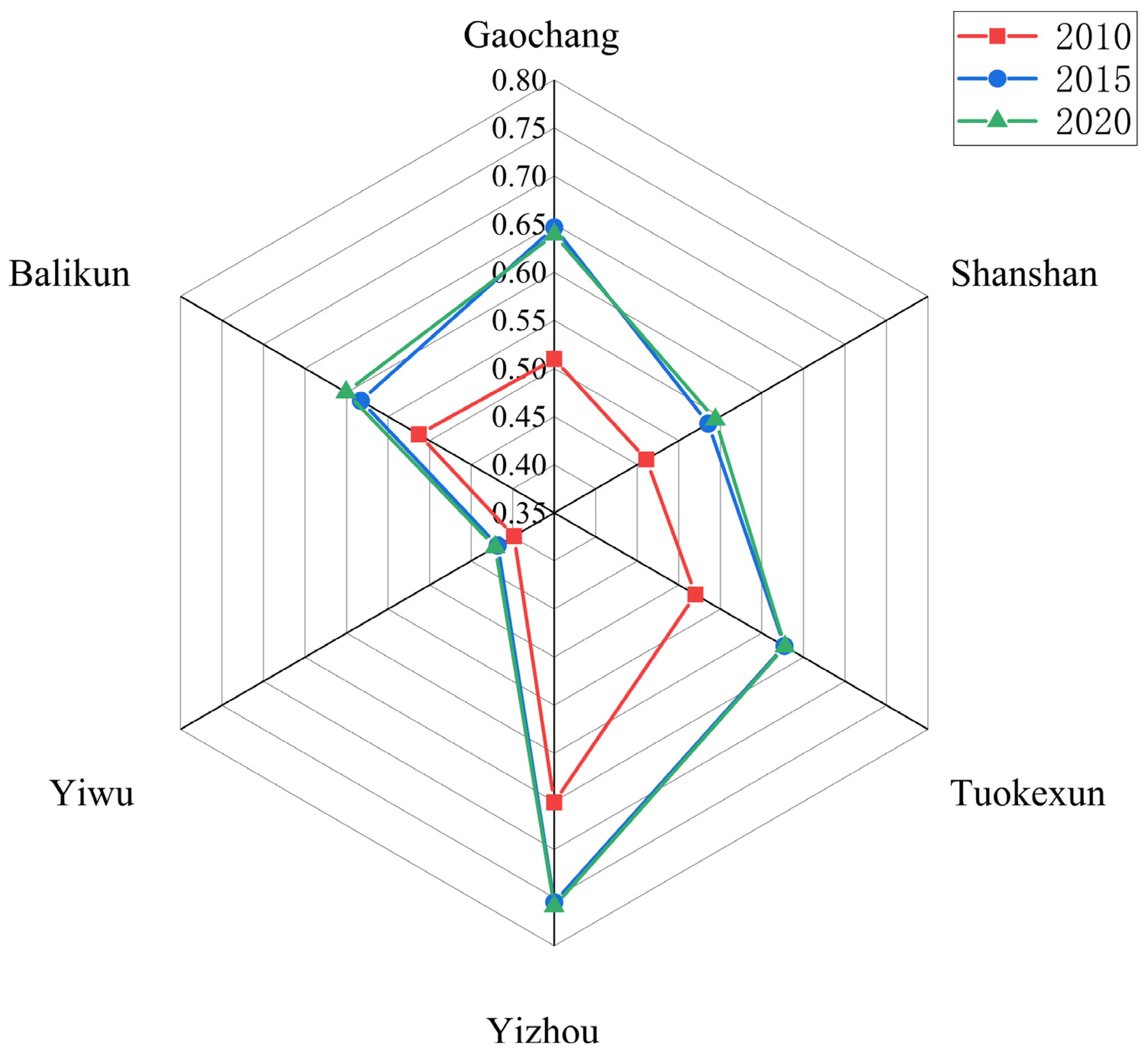

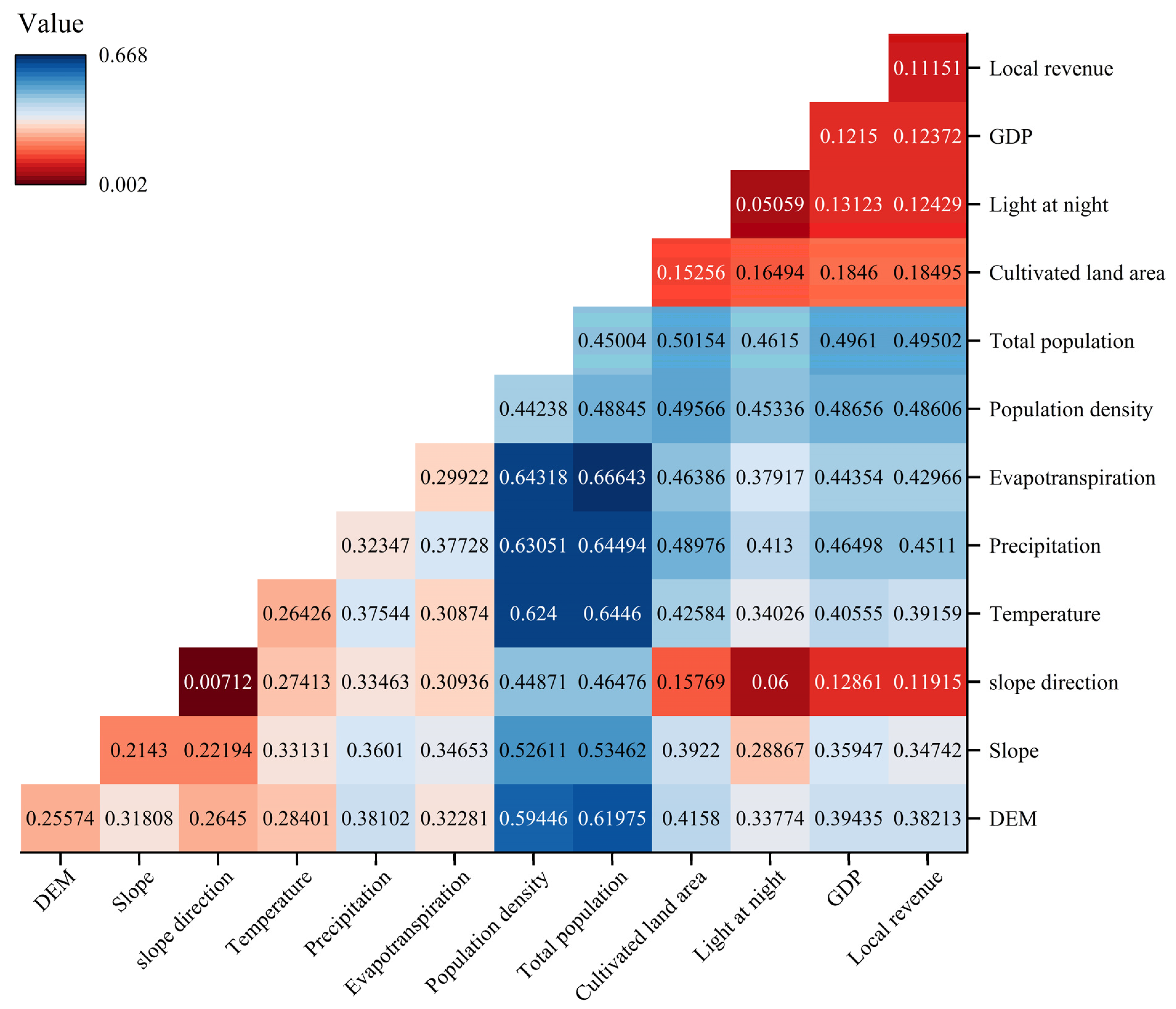
| Data | Time | Resolution | Data Sources |
|---|---|---|---|
| DEM | 2020 | 30 m | Geospatial Data Cloud (http://www.gscloud.cn, retrieved on 15 January 2024) |
| Land use | 2010~2020 | 30 m | Resource and Environmental Science Data Center of Chinese Academy of Sciences (http://www.resdc.cn, retrieved on 23 April 2024) |
| China Soil Database | 2020 | 1 km | World Soil Database(HWSD) (https://soilgrids.org, retrieved on 23 April 2024) |
| Population Density | 2010~2020 | 1 km | Resource and Environmental Science Data Center of Chinese Academy of Sciences (http://www.resdc.cn, retrieved on 23 April 2024) |
| Annual Precipitation | 2010~2020 | 1 km | National Earth System Science Data Center (http://gre.geodata.cn, retrieved on 28 April 2024) |
| Evapotranspiration | 2010~2020 | 1 km | National Earth System Science Data Center (http://gre.geodata.cn, retrieved on 28 April 2024) |
| Temperature | 2010~2020 | 1 km | National Earth System Science Data Center (http://gre.geodata.cn, retrieved on 28 April 2024) |
| Social statistical data | 2010~2020 | \ | Xinjiang Statistical Yearbook, Turpan Statistical Yearbook, Hami Statistical Yearbook |
| POI | 2010~2020 | \ | GaoDe |
| Primary Classification | Secondary Classification | Code | Land Use Classification |
| Productive space | Agricultural production space | 11/12 | Paddy land, dry land |
| Industrial and mining production space | 53 | Industrial and mining land | |
| Living space | Urban living space | 51 | Urban land |
| Rural living space | 52 | Rural settlement | |
| Ecological space | Woodland Ecological space | 21/22/23/24 | Forestland, shrubland, open forestland, other forestland |
| Grassland Ecological space | 31/32/33 | High coverage grassland, medium cover grassland, ground cover grassland | |
| Water ecological space | 41/42/43/44/46 | River channels, lakes, reservoirs, ponds, floodplain | |
| Potential ecological space | 61/62/63/64/65/66/67 | Sandy land, Gobi Desert, saline-alkali land, marshland, bare land, bare rocky land, other unused land |
| System Level | Rule Layer | Indicator Layer | Direction | Weight |
|---|---|---|---|---|
| Production Function | Agricultural Production Function (60%) | Grain Yield | + | 0.111 |
| Cotton Yield | + | 0.127 | ||
| Effective Irrigated Area of Farmland | + | 0.052 | ||
| Number of Livestock at Year-end | + | 0.025 | ||
| Total Sown Area of Crops | + | 0.052 | ||
| Cultivated Land Area | + | 0.053 | ||
| Aggregate Power of Agricultural Machinery | + | 0.066 | ||
| Fruit Yield | + | 0.053 | ||
| Rural Fertilizer Usage | − | 0.017 | ||
| Gross Production Value of Agriculture, Forestry, Animal Husbandry, and Fisheries | + | 0.039 | ||
| Non-Agricultural Production Function (40%) | Aggregate Social Fixed Asset Investment | + | 0.074 | |
| GDP | + | 0.072 | ||
| Per Capita GDP | + | 0.081 | ||
| Proportion of Primary Industry Output Value to GDP | + | 0.045 | ||
| Proportion of Secondary Industry Output Value to GDP | + | 0.019 | ||
| Proportion of Tertiary Industry Output Value to GDP | + | 0.038 | ||
| Local Fiscal Revenue | + | 0.076 | ||
| Living Function | Basic Livelihood Security Function (47%) | Number of Hospital Beds per 10,000 Population | + | 0.071 |
| Number of Healthcare Technicians per 10,000 Population | + | 0.097 | ||
| Fiscal Expenditure on Healthcare | + | 0.086 | ||
| Fiscal Expenditure on Education | + | 0.078 | ||
| Resident Fixed Asset Investment | + | 0.135 | ||
| Social Welfare Security Function (53%) | Aggregate Retail Sales of Consumer Goods | + | 0.178 | |
| Total Population | - | 0.036 | ||
| Average Wage of Employees on Duty | + | 0.094 | ||
| Total Rural Economic Income | + | 0.108 | ||
| Total Employment in Society | + | 0.116 | ||
| Ecological Function | Ecological Protection Function (100%) | Water Yield | + | 0.217 |
| Carbon Storage | + | 0.393 | ||
| Soil Retention | + | 0.147 | ||
| Habitat Quality | + | 0.242 |
| Developmental Stage | Value Range | Type of Coupling |
|---|---|---|
| Low-degree coupling coordination | [0,0.2) | Severe disorder |
| [0.2,0.4) | Mild disorder | |
| Moderate coupling coordination | [0.4,0.6) | Basic coordination |
| High coupling coordination | [0.6,0.7) | Primary coordinated development |
| [0.7,0.8) | Intermediate coordination | |
| [0.8,1) | Quality and coordinated development |
| Criterion of Interval | Interaction |
|---|---|
| q(X1∩X2) < min[q(X1), q(X2)] | Nonlinear weakening |
| min[q(X1), q(X2)] < q(X1∩X2) < max[q(X1), q(X2)] | Single-factor nonlinear weakening |
| q(X1∩X2) > max[q(X1), q(X2)] | Dual factor enhancement |
| q(X1∩X2) = q(X1) + q(X2) | Independence |
| q(X1∩X2) > q(X1) + q(X2) | Nonlinear enhancement |
| Classify | 2010 | 2015 | 2020 |
|---|---|---|---|
| Agricultural production space | 3,543,476 | 3,551,928 | 3,497,885 |
| Industrial and mining production space | 370,597 | 762,868 | 738,207 |
| Urban living space | 111,825 | 119,647 | 157,791 |
| Rural living space | 153,527 | 164,144 | 212,309 |
| Forestland ecological space | 695,974 | 688,754 | 651,241 |
| Grassland ecological space | 46,720,162 | 46,670,539 | 46,656,402 |
| Water ecological space | 416,995 | 417,304 | 446,866 |
| Potential ecological space | 182,789,717 | 182,417,840 | 182,441,484 |
| 2010 | 2020 | |||
|---|---|---|---|---|
| Production Space | Living Space | Ecological Space | Transfer Out | |
| Production space | 3209.96 | 82.69 | 230.00 | 312.69 |
| Living space | 13.31 | 222.53 | 2.98 | 16.29 |
| Ecological space | 589.21 | 27.87 | 206,933.88 | 617.08 |
| Transfer in | 602.52 | 110.57 | 232.98 | \ |
Disclaimer/Publisher’s Note: The statements, opinions and data contained in all publications are solely those of the individual author(s) and contributor(s) and not of MDPI and/or the editor(s). MDPI and/or the editor(s) disclaim responsibility for any injury to people or property resulting from any ideas, methods, instructions or products referred to in the content. |
© 2024 by the authors. Licensee MDPI, Basel, Switzerland. This article is an open access article distributed under the terms and conditions of the Creative Commons Attribution (CC BY) license (https://creativecommons.org/licenses/by/4.0/).
Share and Cite
Gao, Y.; Bai, L.; Zhou, K.; Kou, Y.; Yuan, W.; Zhou, X.; Qiu, Z.; Zhao, D.; Lv, Z.; Wu, Q.; et al. Study on the Coupling Coordination Degree and Driving Mechanism of “Production-Living-Ecological” Space in Ecologically Fragile Areas: A Case Study of the Turpan–Hami Basin. Sustainability 2024, 16, 9054. https://doi.org/10.3390/su16209054
Gao Y, Bai L, Zhou K, Kou Y, Yuan W, Zhou X, Qiu Z, Zhao D, Lv Z, Wu Q, et al. Study on the Coupling Coordination Degree and Driving Mechanism of “Production-Living-Ecological” Space in Ecologically Fragile Areas: A Case Study of the Turpan–Hami Basin. Sustainability. 2024; 16(20):9054. https://doi.org/10.3390/su16209054
Chicago/Turabian StyleGao, Yue, Linyan Bai, Kefa Zhou, Yanfei Kou, Weiting Yuan, Xiaozhen Zhou, Ziyun Qiu, Dequan Zhao, Zhihong Lv, Qiulan Wu, and et al. 2024. "Study on the Coupling Coordination Degree and Driving Mechanism of “Production-Living-Ecological” Space in Ecologically Fragile Areas: A Case Study of the Turpan–Hami Basin" Sustainability 16, no. 20: 9054. https://doi.org/10.3390/su16209054
APA StyleGao, Y., Bai, L., Zhou, K., Kou, Y., Yuan, W., Zhou, X., Qiu, Z., Zhao, D., Lv, Z., Wu, Q., Zhang, F., & Zhang, Q. (2024). Study on the Coupling Coordination Degree and Driving Mechanism of “Production-Living-Ecological” Space in Ecologically Fragile Areas: A Case Study of the Turpan–Hami Basin. Sustainability, 16(20), 9054. https://doi.org/10.3390/su16209054






